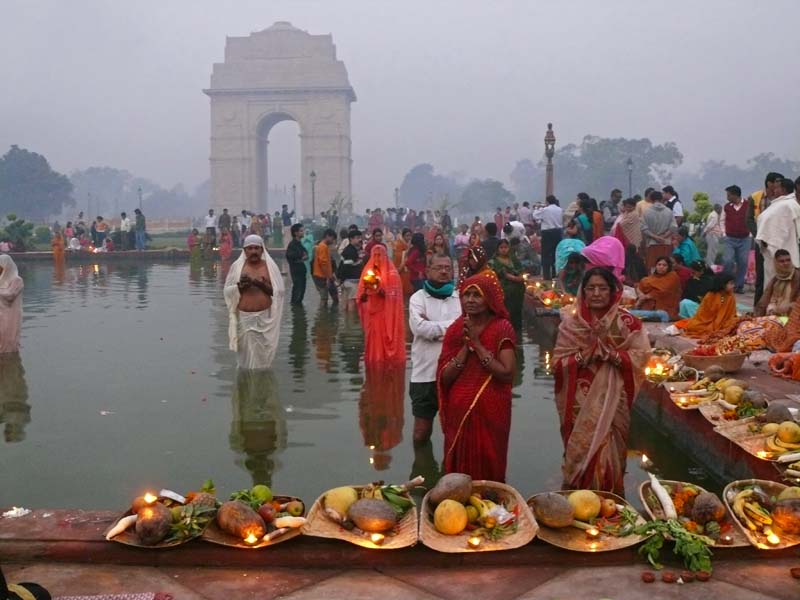This is an unusual Hindu holiday, which originated in ancient times and has preserved its extraordinary attractiveness and enchanting beauty up to now. It is dedicated to Surya - the Solar Deity in the mythological pantheon of Hinduism. Both the traditional Indian medicine and yoga - recognizing the enormous healing power of the daylight, which helps to heal many diseases, strengthen health, bring the prosperity and well-being to people and the world around us - worship the Sun, the greatest source of light and energy, on which depends the very existence of all the life on Earth.
The Chhath festival is held according to the Lunar calendar and comes in autumn, on the sixth day of the Khartik month, short after the celebration of the Festival of Lights - Diwali, which marks the end of agricultural work. This year, it fell on November 2.
The origin of the tradition
The North Indian state of Bihar is the center and birthplace of the festival, during which people bring prayers and offerings to Surya and his wife Usha, the Goddess of the Daybreak. The festival enjoys the greatest popularity in the eastern states of India, but the celebrations lasting four days take place throughout the country.

It is generally accepted that the origin of the festival’s name reflects both its connection with the Hindu calendar (‘chhath’ in Hindi means ‘six’), and the combination of two concepts from the Indian yoga: ‘chah’ meaning ‘six steps’, and ‘hath’ meaning ‘austerity’.
Experts say that the Chhath Puja rituals are borrowed from the ancient Vedic texts, since they are very similar to the descriptions of Sun worshiping, which are in the ‘Rigveda’ and in the epic poem ‘Mahabharata’. In the yoga, the holy ‘rishis’ - mentors, gifted and inspired seers, necessarily carried out similar sun-worship rituals, since, in their opinion, these rituals made it possible to use the human body's ability to do without water and food receiving the necessary vital powers directly from the sunlight.
In accordance with a strict tradition, this is a period for the devotees to be fasting and abstaining from drinking water, as well as to be performing ablutions and standing in water for a long period of time and performing the ceremonies of worshiping the Sun rising or setting. The contact with water and prolonged meditative staying in it are an essential part of the ceremonies. It is noteworthy that this is one of the rare Hindu holidays in which priests are not involved at all: prayer communication with the Sun implies detachment from the vanities of the world, although it takes place together with the relatives around and with a huge number of other participants in the ritual.
Praying and Fasting
On the eve of the holiday, it is required to carefully clean the house and around it, keep fasting, and it is forbidden even to drink during the last 36 hours. Particularly important are the rituals performed during the last day of Chhath - in the evening, at sunset and the next morning, at sunrise. Believers are supposed to cook symbolic offerings to Surya, which include simple Indian sweets, pastries, bananas, apples, grapes and other fruits, sweet potatoes, sugarcane cut into small pieces, coconuts. All this is usually laid out in special baskets, instead of which wide bamboo winnows are often used, like those that are commonly used by Indians in everyday life to sift grains through.
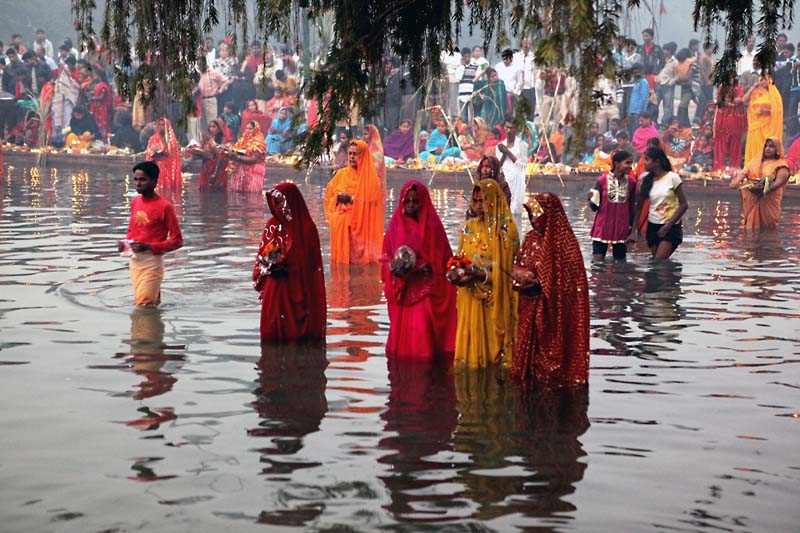
Every devotee of Surya seeks to meet the beginning of the Chhath festival in the waters of the holy Ganga or any other sacred Indian river. But hundreds of thousands of participants in the festival gather by the riverbank or at the shores of the nearest ponds. In recent years, even ordinary swimming pools have been used for the rituals. And the authorities of the Indian capital granted the opportunity to worship the Sun in the iconic place next to the Gateway of India memorial: devotees are allowed to use one of the decorative water reservoirs stretching on both sides of the central Rajpath Avenue, and - moreover - the fountain that frames the rotunda, under the dome of which there was once a marble statue of the British monarch.
Another feature of Chhath Puja is that its main characters are women, they must pray for the divine benevolence of the Sun to their family members and dear ones.
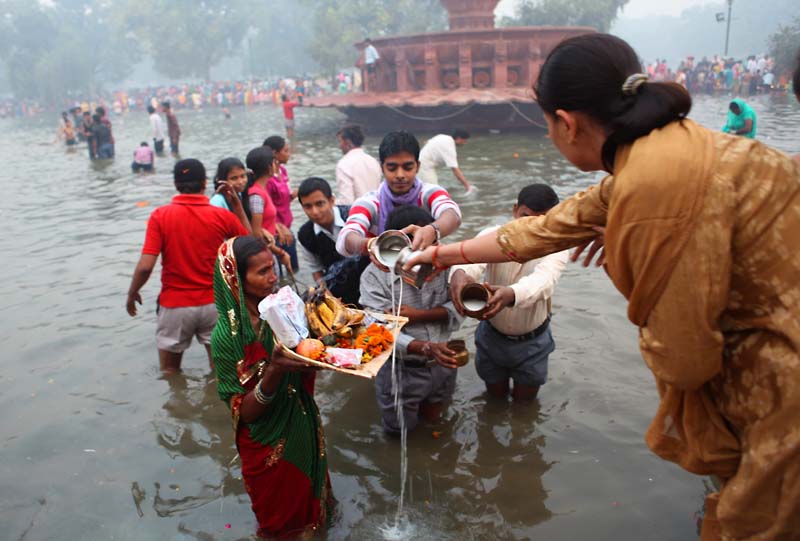
The ancient ritual of worshiping Surya is accompanied by prayers that women perform in the early dawn standing in water. It is believed that this way, it is possible to gain the support of the deity who gives energy and powers to all living things, and also to get rid of diseases and ailments, receive a blessing in your good undertakings, and open the way to the well-being and prosperity of your family and friends. Women enter water long before the first light of the day. In Northern India, the nights at this time of the year are already pretty cool, and standing in water for hours requires considerable patience and even self-sacrifice.
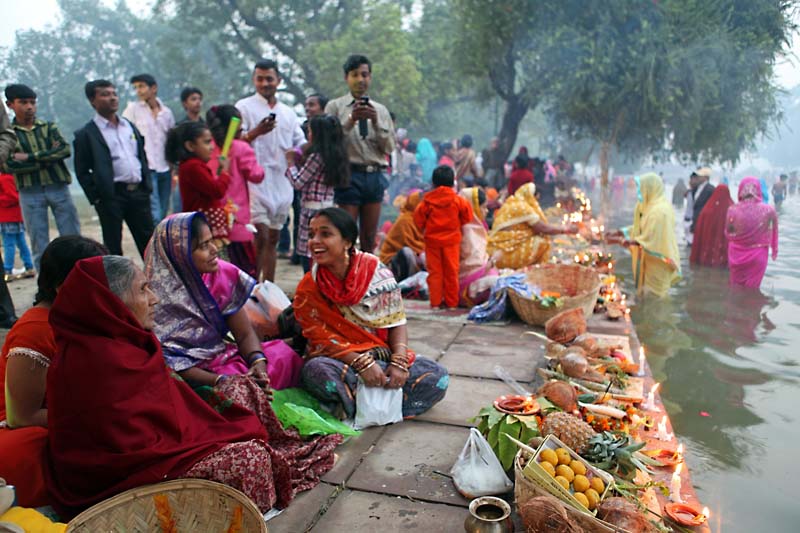
Men also take part in the rituals, but more often - only as those to whom the grace received from Surya is redirected. The tradition requires that the family in which Chhath Puja was held once should continue to follow this custom from one generation to another, from year to year. Exceptions are allowed only if the family is in mourning in connection with the death of a family member.
Tourist’s experience
The ritual ceremony, which can be seen even in the heart of New Delhi, is beyond all expectations. Spectators, regardless of their nationality and faith, dig into the strange, electrified atmosphere of awesomeness, mysticism and the anticipation of a miracle. Along the banks of the ponds, the bright lights of plenty candles and oil clay lamps - ‘dipa’ - flicker. The gently melting twilight is also colored with bright saris, orange garlands of fragrant marigolds. Most of the women standing in water hold burning lamps, smoking incense sticks, flowers, coconuts. Many worshipers in wet clothes tremble with cold, but patiently undergo this hardship.
At this moment, hundreds of people gathered along the water are busy with final preparations, take care of their neatly laid out gifts, and the light-hearted young groups, without waiting for the cherished moment, light firework sparklers and intricate pyrotechnic crackers illuminating the surroundings with sparkling fountains of fire.
Immediately with the onset of sunrise, the ritual ceremony culminates. All the men join the pretty cold women standing in water. Praying and holding trays and baskets with gifts, the women make one turn in a circle several times and freeze for a while to allow men to pour some milk from the steel jugs or clay pots into water. At the end of the joint worship, some of the most ardent admirers of Surya decide even to be soused head and ears in water.
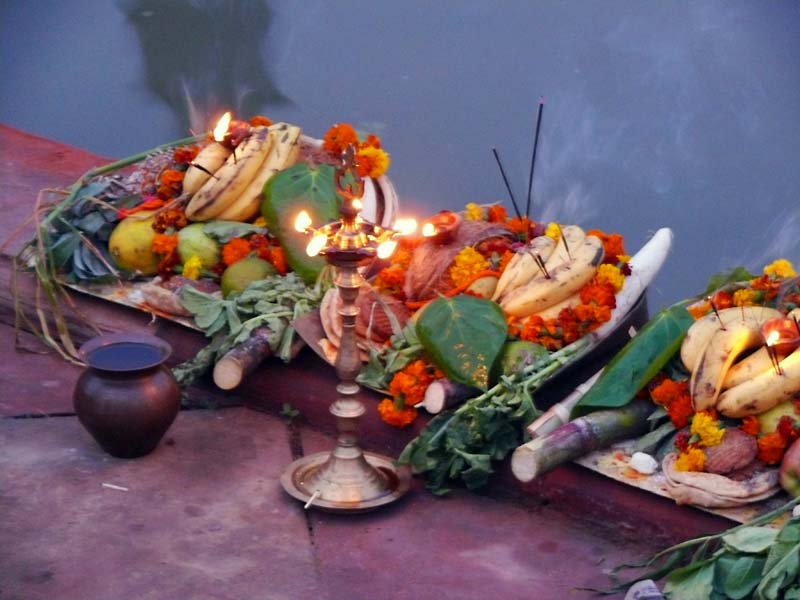
As soon as the Sun fully reveals its bright holy face, a real flurry of exaltation passes through the crowd of people, they glorify Surya with an unharmonious choir of sacred mantras and joyful exclamations, and then they begin congratulating each other, treating themselves to sweets and fruits. Then, they neatly wrap up the food and take most of it along with them so that they can have a family meal together at home with these ritual gifts that absorbed the energy of the Sun during the celebration of Chhath Puja ...

